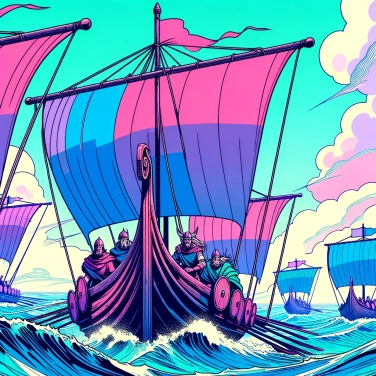In detail, for those interested!
Why did the Vikings use longships?
The Vikings used drakkars for their maritime expeditions because of their specific design adapted to the needs of navigation in coastal and river waters. These long and slender ships were fast and maneuverable, making them ideal for sailing in the narrow fjords and shallow rivers of Scandinavia. In addition, drakkars were equipped with sails and oars, offering great versatility in terms of propulsion, which was crucial for navigating in variable and often unpredictable weather conditions in the North Sea. This allowed the Vikings to move quickly and efficiently along the coasts to launch lightning attacks, explore new territories, or trade with other peoples. In summary, drakkars represented the ideal maritime tool for the Vikings, combining speed, agility, and adaptability to their exploration and conquest-based way of life.
Features of the drakkars
The longships were long and narrow vessels, usually measuring between 16 and 37 meters long and capable of carrying up to a hundred warriors. Their hull was made of wood, typically oak, making them both light and sturdy. These ships had a single row of oars on each side, maneuvered by rowers during sea voyages.
The longships were also recognizable by their sleek bow and stern, often adorned with complex carvings depicting mythological figures or animals. These ornaments gave the longships an intimidating and impressive appearance, enhancing the Vikings' reputation for power during their expeditions.
In addition to their imposing look, the longships were also equipped with a square linen sail, allowing Viking navigators to take advantage of favorable winds to sail faster and more efficiently on the seas. This combination of rowing and sail propulsion gave the longships great versatility and the ability to navigate in a variety of weather conditions.
The longships were designed with a shallow draft, meaning they were able to explore shallow waterways, essential for Viking expeditions that often had to navigate coastal waters and rivers to reach their destinations.
In summary, longships were impressive and innovative vessels, with unique features that made them perfectly suited to the Vikings' needs for maritime expeditions, combining power, agility, and versatility.
Benefits of Drakkars for maritime expeditions
The long, narrow ships called drakkars, used by the Vikings for their maritime expeditions, offered several undeniable advantages. Firstly, their design allowed for great maneuverability, making navigation easier in the often tumultuous waters of the North Sea. Moreover, their light but robust structure gave them a superior speed compared to other types of ships at the time, which was a crucial advantage during raids and explorations. Drakkars were also versatile, able to sail both on the open sea and on narrower rivers, providing the Vikings with great freedom of movement during their expeditions. Finally, thanks to their shallow draft, drakkars could easily dock on shallow beaches, enabling the Vikings to reach territories inaccessible to larger ships. In summary, drakkars were exceptionally well-suited ships for the Vikings' needs during their sea voyages and conquests.
![Explain why some countries change time zones?]()
![Explain why Alexander the Great refused to wear shoes.]()
![Explain why Alexander the Great always wore an impressive helmet.]()
![Explain why the last Chinese emperor was so young when he came to power?]()





















